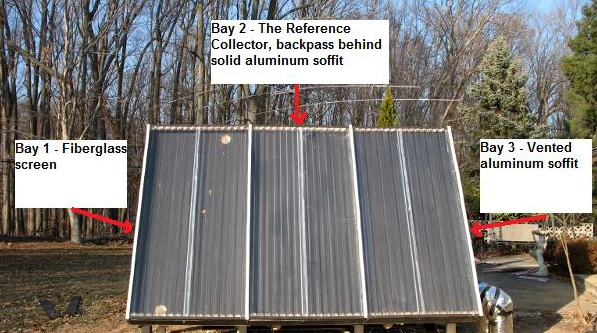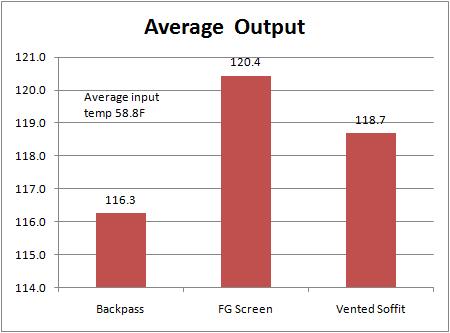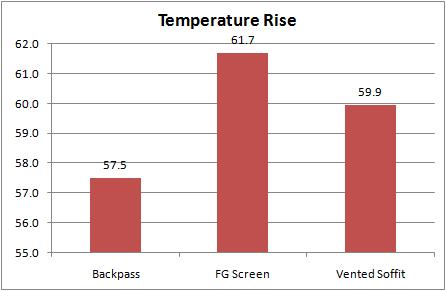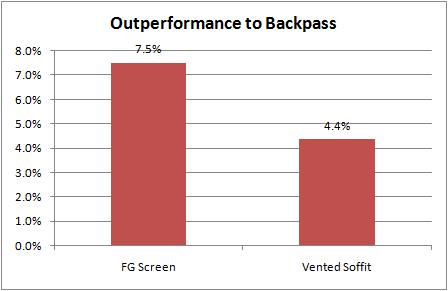The
Best Solar Collectors
Comparing
Solar Hot Air Collector Design Performance
Hot
Air Collectors - Choosing
the Best
There
are lots of different hot air solar collector designs to choose
from, but which is the best?
It seems like an easy question. If my collector's output temperature is hotter than yours, it must be better, right? Not so fast! There are tons of folks, particularly on YouTube, touting really high output numbers with their designs, but if you blow more than a breath of air through their collectors, their output temperatures might just fall like a rock!
Along with temperature rise there is another, equally important variable. It is the amount of air flowing through a collector, which is usually measured in cubic feet per minute (CFM).
In basic terms, If my collector is as hot as yours, but you have twice the air flowing through your collector, yours is working twice as well! If I raised my airflow to equal yours, my temperature increase would only be half of what yours is.
Both temperature rise and airflow are integral to comparing hot air collectors. This is a really important concept to keep in mind. As soon as someone tells you how hot their collector is, the first thing you should be wondering is how much air they are flowing through it. If it isn't much, the hot temperatures they are touting don't mean much. This same principle applies to water collectors too.
At this point you may be thinking that as long as we measure our temperature rise and adjust for airflow, it should be straightforward to compare collector performances. Again, not so fast! We've accounted for the two biggest variables, but by no means all of them. Here are a few more:
-
Even on days that appear perfectly sunny, high, thin clouds
that are virtually invisible can vary the sun's intensity quite
a bit.
- The outside temperature might be colder at my
house than yours, affecting the performance some.
- The collectors might be at different
tilt angles or aren't quite facing the same direction, which also
affects the sun's intensity striking the collector.
- It
might be windier at your house, pulling more heat off the glazing
The only reliable way to determine the performance of one collector to another is to compare them side by side under identical conditions.
Gary Resa of www.builditsolar.com in Montana and I, here in Maryland, set out to do just that in a collaborative effort. Here is a picture of my test collector, consisting of three, 4' X 8' bays. Each bay has an airtight separation from the others and each is fed individually.

My
three bay test collector (screen not yet installed in Bay 1)
It is absolutely amazing! Here we are in the 21st Century and there is still tons of fertile ground for experimentation by the solar hobbyist / enthusiast. There are many designs and materials to try and the opportunity to learn and to contribute to the art and science of DIY solar!
Enthusiasts in other areas of interests like backyard astronomy or Amateur Radio have been helping to move those disciplines forward at both the hobbyist and professional level for decades. Meanwhile, solar is equally fun, interesting, obviously needed, less expensive to pursue and actually returns your investment many times over; yet there are opportunities everywhere for the backyard solar enthusiast yet to explore! Plus, there are tax credits available too. While the tax legislature usually changes with each year, most personal tax prep software packages are automatically equipped to handle it. If you have an interest in experimenting with solar, please join us. Your ideas could make a difference on a scale bigger than you can possible imagine and you'll have a lot of fun along the way!
Before my Recommendations - First, a Few Prefaces
We have hardly scratched the surface on our testing process. In fact, we are still figuring out the best ways to perform the tests, much less trying different variations of our current absorber types. Then we have countless other types of materials to try. More folks testing different designs or corroborating our tests would be extremely helpful in moving the process forward! So, you may be wondering why I'm already offering some conclusions and recommendations. There are a few reasons:1. This testing process could take a lifetime for several of us Right now, there are only two or three of us doing these tests. If folks wait for the "final" answer, they'll never build anything. It's like waiting to buy a computer until the processors quit getting better - you'll never own one!
2. While we have a heck of a lot of testing ahead, we have gleaned at least some reasonable data on direct, comparative testing with four different, popular, collector designs, - a backpass reference collector, an empty box, a vented soffit and a fiberglass screen collector. In addition, while we don't have side by side comparison numbers, we have very good data on a 5th design - the aluminum downspout, compiled mostly by Scott S and to a lesser degree myself. Also, we have some first hand experience on building a variety of collectors and an estimate of their costs. That's good, final data that helps with our conclusions at present.
3. I continue to get a lot of direct e-mail asking for performance data updates and design recommendations from folks eager to get started on their collectors. They wonder what I would recommend now, based on what we've learned so far.
Current Recommendations
Some
of you may be quite interested in the testing details and
I have included them below, but for those who are interested in
conclusions and recommendations so far, if someone were to ask me today
what type of hot air collector I would recommend building, I would
answer them this way:
For a traditional, 4' X 8' design, I would build a collector with a two or three layer
aluminum window screen.
- Best comparative performance
- Least expensive by far (a 25 foot roll of 4 foot wide, aluminum screen
is only about $29 at Home Depot). Fiberglass screen is even
cheaper and performs great, but we are uncertain about the paint
at really high temperatures.
- Easiest, quickest build by far
- Lowest pressure drop (least resistance to airflow besides a black
box) That means you can get a higher airflow for better efficiency than
you would experience with the same sized fan and other collector types.
Here are some examples of how to build a screen collector:
My two layer screen collector: http://groups.yahoo.com/group/SimplySolar/photos/album/1082811597/pic/list?mode=tn&order=ordinal&start=1&dir=asc
Gary Resa's, three layer collector: http://www.builditsolar.com/Experimental/AirColTesting/ScreenCollector/Building.htm
A YouTube video detailing the screen absorber construction:
For a long, low collector, I would build an aluminum downspout design.
- Good performer. We don't have side by side comparative
performance numbers, however, Scott S. did some very detailed
measurements and calculations that show the aluminum downspout design works
really well. You'll find complete construction details and
Scott's data documenting the performance at the bottom of the page here: http://www.n3fjp.com/solar/solarhotair.htm
- Very easy to build
- Downspout material lends itself to a long, low construction design.
This gives almost unlimited flexibility in design dimension
options.
A YouTube video detailing the aluminum downspout solar collector construction:
Though it is also a good performer, I would steer folks away from the backpass design due to the extremely high pressure drop.
I would definitely steer folks away from the black box due to the poor comparative performance.
The vented soffit appears to be a very good performer and is also a
good choice. I would choose the screen, however, because the screen
appears to be performing slightly better, it is much cheaper, easier and
quicker to build.
So, there you have it. Based on what I know today, those are my recommendations.
We have tons to learn. Who knows what may come to light down the road,
but if you are planning to build a collector, don't wait. The screen
and downspout collectors are easy to build and they work great. In the mean time,
the longer you wait, the more days of sunshine go by before you ever
have a collector for them to shine on. Any
collector will work infinitely better than no collector!
What about aluminum downspout collectors compared to screen?
Questions come up all the time on how aluminum downspout collectors compare to the screen collectors. The aluminum downspout collector is a super design that has become very popular. There have been lots of good reports on the downspout design, I think in part because a downspout collector has lots of the ingredients of a successful design:- It keeps the heated air contained in the downspouts, well away from the glazing. It doesn't mix with the air outside the downspouts inside the collector at all
- There is no moving air at all near the glazing
- The downspout wraps all the way around the airflow, so there is a lot of heat transfer area for the air the rub against
- It is very easy to seal so there is no outside air infiltration
I
haven't done any side by side testing of the downspout collector compared to
screen in my test collector. I thought about it, but then realized that
the configuration in the test collector would not be representative of
how folks are building the long low design with downspouts. Both designs
work
great, so I think the choice comes down to the dimensions of the
collector you plan to build. I'd opt for the downspout collector for a
long collector and screen for a tall collector.
Testing
Details
Gary Resa of www.builditsolar.com and I have been working on this project in a collaborative effort. We would love to have you join us! Here is a link to Gary's test details and results:
http://www.builditsolar.com/Experimental/AirColTesting/Index.htm
Mine are as follows:
Here is a YouTube Video summarizing the characteristics of a high performance, hot air collector and our results so far:
:
Testing Premise - Using a Reference Collector for Comparison:
As explained above, there are lots of variables that make side by side testing a challenge, but Gary and I wanted to come up with a way for folks who are geographically separate from each other to be able to contribute with meaningful, comparative data. We also wanted to have a baseline to compare various designs at our own locations on different days and inevitably different conditions.
What we decided to do was to each build a baseline, reference collector that is easily duplicated, so that the relative performance should be identical. The reference collector would not ever be changed. Other collectors would be run against the reference standard in side by side tests, with the primary result - temperature rise - being compared. In other words, if the reference standard raises the temperature 50 degrees and collector B raises the temperature 60 degrees with the same air flow, collector B can be said to outperform the reference standard by 20% (10 / 50).
Presently, we are using a backpass design for the reference collector, documented in detail on Gary's site. The backpass works well, but we are considering the possibility of selecting a different reference design, because the backpass requires a lot more pressure to move air through than other designs.
Air Flow
With accurate sensors, measuring the temperature entering and exiting the collector is easy. Measuring airflow is another matter entirely. We have tried bag tests, measuring the voltage of computer fans and inserting an anemometer in the air stream. The bag test may be the most accurate, but it wasn't an option for my configuration here. These two short videos show how I'm balancing flow:
I am also inserting a Kestrel anemometer in the air stream as a secondary check on air flow.
Results so Far
So far, I have compared the reference backpass to the fiberglass screen and vented soffit designs here. In addition, Gary has also compared the black box and has data for that. Averaging measurements over a two day period, here are my results for the backpass standard, fiberglass screen and vented soffit:



So, the two layer fiberglass screen collector is outperforming the backpass by an average of 7.5%, giving it a clear advantage over the reference backpass and vented soffit collector. In addition, it was by far the easiest, quickest and least expensive collector to make.
That's where we are so far. I hope to update this page as additional tests are performed. Right now, the fiberglass screen collector is the heat absorber to beat. Do you think you can come up with a design that can? I would love to see you do it! Bring it on, we will all win!!!
If you have an interest in brainstorming and testing solar projects, or you are brand new to solar and want some help getting started, we would love to have you subscribe:
SimplySolar - Solar Forum and E-mail Groups!
I originally set up an e-mail group - SimplySolar, for that purpose. The e-mail group has served us well, but with overwhelming growth and interest in the e-mail group, to better keep content organized and give members the option to easily follow only the threads that interest them, we have just set up a new Simply Solar on line forum! SimplySolar is about brainstorming and sharing ways to implement solar heat in easy ways that the average homeowner, who may not be much of a "do-it-yourselfer" (like me), can use to put money back in their pockets, green back in the environment and have a lot of fun along the way! If solar excites you, we would love to have you join our forum:
Click to visit or join the Simply Solar Forum
or subscribe to our e-mail group!
![]()
